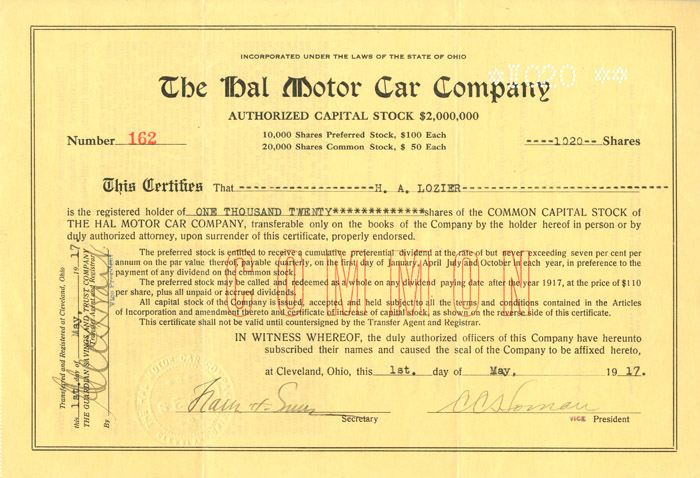Hal Motor Car Co. - Automotive Stock Certificate
Inv# AS1296 Stock
Hal was started in 1916 by owner Harry A. Lozier. The company was not around very long. Due to health reasons, Harry Lozier left the company in September of 1916 and was taken over by A. Ward Foote, who re-named the company HAL Motor Car Company. In October 1917 HAL merged with Abbott Corporation but unfortunately declared bankruptcy in January 1918.
The HAL (or sometimes HAL-Twelve/HAL-12) was a Brass Era car made in Cleveland, Ohio from 1916 to 1918. HAL stands for the initials of the founder—Harry A. Lozier.
Harry Lozier stated in June 1915 that "only an accident... prevented the formation of my company last summer." Harry Lozier was upset that Lozier Motor Company stockholders had taken his decidedly luxury self-named car downmarket. So he did what Ransom E. Olds and Harry C. Stutz did before him—create a new car company using his initials as the name of the car. Thus was the H.A. Lozier Company formed. A prototype using a Weidely V-12 engine was displayed at the New York Automobile Show in January 1916. Production of the $2100 car commenced in Cleveland that summer, though the price would rise as time went on. The former Royal Tourist factory was used, which had been leased from the F.B. Stearns Company. Harry Lozier left the company in September 1916 for health reasons. The company was now renamed the Hal Motor Car Company, with A. Ward Foote of the Foote-Burt Machine Company as president.
Company brochures stated that even though the engines of the HAL-Twelve were rated at 40 hp, they actually developed over 70 at 2000 RPM, and 100 at 3000 RPM. Among the prominent owners of HALs during this period was none other than Warren G. Harding, though he would switch to Locomobiles by the time he became president. The continuing war resulted in materials shortages. There was a rumor in October 1917 that HAL would merge with the Abbott Corporation, recently moved to Cleveland from Detroit. Unfortunately, Abbott declared bankruptcy in January 1918, while the Hal Motor Company was petitioned into involuntary bankruptcy the next month, on creditors' claims of only $1500. The Hal assets were auctioned off in April, thus ending Harry Lozier's 2nd automotive venture named after himself.
The Lozier Motor Company was a brass era producer of automobiles in the United States of America. The company produced luxury automobiles from 1900 to 1915, with a factory at 3703 Mack Avenue, Detroit, Michigan.
The company was founded in Plattsburgh, New York by Henry Abrahm Lozier, an Indiana-born sewing machine and bicycle manufacturer.
After selling his bicycle business, Lozier moved to Plattsburgh to manufacture boat engines. In 1900, he entered the automobile business. At his death in 1903, his son Harry took over the company.
Loziers were top line luxury cars and for a time were the most expensive cars produced in the United States. The 1910 model line featured cars priced between US$4,600 and US$7,750. The same year, a Cadillac could be had for about US$1,600 and a Packard US$3,200. A pre-assembly line Ford Model T of the same year retailed at approximately US$850 (after installing assembly line production a few years later, new Model Ts sold for as little as US$240). The average annual salary in America that year was approximately US$750.
The company was moved to Detroit in 1910. In 1911, a Lozier was entered into the first running of the Indianapolis 500. The car, in the hands of Ralph Mulford, finished second in a controversial scoring decision and many observers felt Mulford's Lozier had actually won the race. On March 19 the same year, Lozier ads claimed, a stock 49 hp (37 kW) model piloted by Teddy Tetzlaff set a world record for 100 mi (160 km) at 1:14:29. The company developed its braking system using pressurized water to cool hollowed brake drums. This led to some claims that Lozier's brakes were "impossible to burn out".
Because of Lozier's limited market niche, the company only produced a few thousand cars during its brief lifespan. Production peaked in the 1912 model year at 600 cars.
The company faced new pressures as more manufacturers entered the market. Frederick C. Chandler, Lozier's top designer, left the company in 1913 and formed the Chandler Motor Company which produced cars similar to the Lozier but at a substantially lower sales price. Chandler took several top company executives with him producing a brain drain from which the company never recovered.
At the 1913 Los Angeles Motordrome, however, the company introduced the 88 hp (66 kW) Big Six, with electric headlights, with tourers and roadsters at US$5,000, limousines and landaulettes at US$6,500. It was joined by the 52 hp (40 kW) Light Six Metropolitan, with electric starter and lights; the tourer and runabout were US$3,250, coupe US$3,850, and limousine US$4,450.
Lozier tried to expand into the mid priced car market and in 1914 offered a four-cylinder car priced at US$2,000. It faced competition from the US$2000 Enger 40, the cheaper FAL at US$1750, the US$1600 Oakland 40, The Chalmers Super Six at US$3200, Cole Four at US$1925, and Western's US$500 Gale Model A roadster, to name just a few. The new four was not a sales success and company finances continued to falter. After a failed attempt to merge with Ford Motor Company, the company declared bankruptcy in 1915.
A stock certificate is issued by businesses, usually companies. A stock is part of the permanent finance of a business. Normally, they are never repaid, and the investor can recover his/her money only by selling to another investor. Most stocks, or also called shares, earn dividends, at the business's discretion, depending on how well it has traded. A stockholder or shareholder is a part-owner of the business that issued the stock certificates.










Ebay ID: labarre_galleries